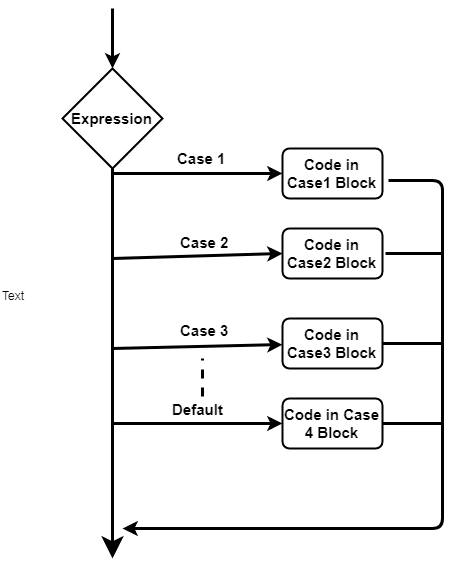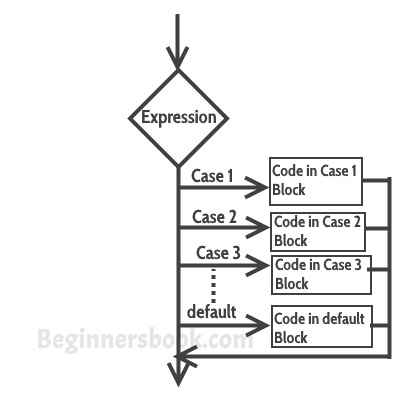

The switch-case construct is a flow control structure that tests value of a variable against a list of values.
#AREA WITH SWITCH CASE JAVA CODE#
Future enhancementsĪs part of the JEP-325 specification, there is also mentioned another improvement, which is not currently implemented (as of Java 13), but may be introduced in the future.Īs a target of opportunity, we may expand switch to support switching on primitive types (and their box types) that have previously been disallowed, such as float, double, and long.Ĭurrently, the switch allows input values only of types char, int, byte, short, their object wrappers (Character, Byte, Short, Integer) and String (since Java 7).This article helps you understand and use the switch case construct in Java with code examples. The original proposal in Java 13 was break-with, which would be the first hyphenated keyword in Java so far.


Switch expression only uses yield and never break.Switch statement only uses break and never yield.Now it is much easier to tell them apart: It was harder to visually distinguish a switch statement from switch expression. Having a break with return value was a bit confusing and hard to tell apart from regular labeled break. Each case is followed by the value to be compared to and a colon. You can have any number of case statements within a switch. There is a new type of syntax available using ->. The following rules apply to a switch statement The variable used in a switch statement can only be integers, convertable integers (byte, short, char), strings and enums. Even with multi-value case blocks, we still had to make sure we included break properly otherwise we could face some nasty fall-through bugs.įortunately, the new switch can prevent this. One of the major nuisances was not covered though. So far we've seen some nice improvements to the good old switch.

Also, you cannot get null pointer exception as a result of the switch expression. This cannot happen with switch expression as you would get compile error.
#AREA WITH SWITCH CASE JAVA UPDATE#
Or when you later add another enum item but forget to update your switch statements. The regular switch is error-prone when you forget to include one of the values, for example when using enums. Either by providing case for all the possible values (which can be easy for enums) or by providing default case. So with switch expression, you have to cover all the possible inputs. Then, in IntelliJ IDEA you can enable preview features under File → Project Structure.Īlternatively, if building manually, you need to provide the following params to javac:Įrror:(11, 26) java: the switch expression does not cover all possible input values Needless to say, it is not intended for production use, but rather for evaluation and experimentation as it may get removed or heavily changed in a future release.įirst, make sure you actually have JDK 13 installed. You need to explicitly enable them to use them. Such features are shipped in the JDK but are not enabled by default. Consequently, the feature may be granted final and permanent status (with or without refinements), or undergo a further preview period (with or without refinements), or else be removed. It is available in a JDK feature release to provoke developer feedback based on real-world use this may lead to it becoming permanent in a future Java SE Platform.īefore the next JDK feature release, the feature's "real world" strengths and weaknesses will be evaluated to decide if the feature has a long-term role in the Java SE Platform and, if so, whether it needs refinement. Preview FeatureĮnhanced switch functionality is, however, currently only available as a preview feature.Ī preview language or VM feature is a new feature of the Java SE Platform that is fully specified, fully implemented, and yet impermanent. It solves most of the issues of the traditional switch and is prerequisite of pattern matching, which is to be provided in the future. Java 12 brought a whole lot of improvements to the traditional switch as Java Enhancement Proposal 325: Switch Expressions (Preview). It is optional to have a break statement within every case statement. Area of a cylinder () (r2) (h) where is Math.PI, r is the cylinder's base, and h is. Area of a circle () (r2) where is Math.PI and r is the circle's radius. The case value should be either literal or constant and cannot be a variable. I'm working on code for a class that asked me to write an Area class that calculates the area for the following shapes: circles, rectangles, and cylinders. Each case statement has a unique value which means it does not allow duplicate values. Unfortunately, the old traditional switch does not support this. Features of Switch case in Java There can be multiple case statements in a switch case in java. println ( "Something is wrong with the request!" )


 0 kommentar(er)
0 kommentar(er)
